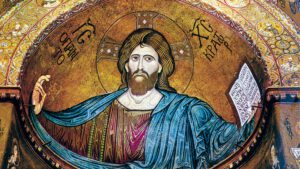It is a matter of joy that religious faith and public opinion in Goa are not dead. Following a public scandal that the laity found it fit to highlight on social media, our archdiocesan bulletin, Renovação/Renewal/Novsornni (Renewal, for short), albeit unusually, responded editorially. The laity’s reaction to the scandal ranges from plain shock to utter disgust, but the editorial stance is one of blind defence and utter coldness to the laity’s cries for clarity on the subject, such as the Catechism of the Catholic Church provides.
Just how does Renewal get on with its defence? The editorial, titled ‘Being Living Witnesses of Christ’ (Vol. LX, No. 18), thrusts upon the readers, in a disjointed and unwieldly manner, a barrage of Church documents but maintains a studied silence on the main issue of concern: whether or not the elephantine blunder in Siolim qualifies as syncretism, idolatry and apostasy![1] It is a pity that the readers, instead of being shepherded to the refreshing waters of Catholic doctrine, are thus left thirstier than ever. So, just why can’t our ‘pastoral bulletin’ be a wee bit more pastoral in its approach?

Is the editorial’s long-winded style indicative of a gulf that exists between the shepherds and the sheep? At any rate, the lead article plays the victim card and, in the same breath, censures the laity for alleged ‘ignorance’ and ‘arrogance’. It may even seem as though the editor is repulsed by ‘the smell of the sheep’ and ‘[in]capable of living, of laughing and crying with your people, in a word, of communicating with them.’[2] Isn’t the church organ falling short of instructing the ignorant as a spiritual work of mercy? And how can the spirit of ‘dialogue’ be allowed to vanish into thin air, as it often happens when it is about dialoguing with the internal public! And how come the full import of a layperson as ‘priest, prophet and king’ suddenly seems unpalatable?
The fact of the matter is that, faced with the public scandal of priests adoring the Ganesh deity, Renewal has evaded the question. Sadly, the editorial misquotes Biblical passages and misses out relevant ones – just as it fails to cite pre-Vatican II documents to buttress the case, if any. (Why? Is the church today a far cry from the pre-Conciliar one?) Then, the editor cites papal and archdiocesan documents that supposedly come in his defence but, really speaking, none of them endorse idolatry – they just can’t! He mentions the CBCI commission for ecumenism and dialogue; several conferences and seminars (on non-Biblical scriptures, on sharing of worship, etc.), but he overlooks the fact that these bodies have no magisterial authority. In this regard, it is interesting to read what Cardinal Ratzinger has to say about episcopal conferences in the Ratzinger Report.[3]
The editor also refers to the first Plenary Council of India (1950), but makes no mention of its rejection of religious indifferentism and of the syncretist view that the religion of the future will be a synthesis of the good elements of all religions. And as for the All India Seminar on Church in India Today (1969), for the implementation of Vatican II in India, Valerian Cardinal Gracias had a word of caution as he presented 1668 pages of preparatory material: ‘If fifty years hence there is to be another Ecumenical Council, it seems to me that the Bishops, the Clergy, the Religious, the laity of that period would be in a privileged position having at hand this abundant material, unless they – which is possible – consider then all this outdated or – which is not improbable – after bitter experiences in experimentation, decide to revert to Vatican I!’[4]
Prophetic words! It may be noted that the seminars mentioned in the editorial have been forums for diffusion of theological errors, which His Eminence the late Jozef Cardinal Tomko denounced at the Fourth Extraordinary Consistory, a meeting of the world’s cardinals, in April 1991. The then Prefect of the Congregation for the Evangelization of Peoples called the bluff of the ‘doctrinal confusion regarding the content of faith’, specifying ‘a gnostic relativism and a theological misunderstanding which levels all religions.’
The said Cardinal pointed out that some theologians ‘have developed unacceptable and destructive doctrines’ that are ‘reducing evangelization to mere dialogue and development, with the abandonment of proclamation, catechesis, and logically, conversions and baptisms. They strongly confirm the basis and justification of two phenomena denounced in the encyclical Redemptoris Missio: “a widespread indifferentism” and “a religious relativism” which leads to the belief that “one religion is as good as another” (n. 36)’
Adding that, by such doctrinal standards, evangelization ‘would consist solely in dialogue, inculturation and liberation,’ His Eminence alerted us to the fact that, ‘according to some Indian theologians, in the search for dialogue, Jesus Christ divides rather than unites’; and that ‘to dialogue as equals, either Jesus Christ is downgraded by not mentioning His divinity, or the founders of other religions are exalted making them quasi-incarnations of God.’ He stated these tendencies have Asia as their ‘main territory’ and India as the ‘epicentre’, and warned against the ‘simply devastating’ consequences of those doctrines.
Those promoting this destructive theology believe that ‘the universal mystery of salvation is accomplished through all religions.’ Cardinal Tomko warns us against those who see salvation as a form of ‘utopia’ that would ‘unite everyone in a community of love, justice and peace’.[5] Three decades down the line, his words are still a providential and urgent warning about the modern errors. A case in point is that heady mix of religious symbols depicted on the cover of Renewal, inscribed with the words ‘Only Love Unites’ – in an awkward bid to equate all faiths. In practical terms, the consequences of such a relativist agenda are there for everyone to see: weakening of the faith and moral decadence; lack of attention to Church Tradition; syncretism, relativism, secularism, and so on. When will the authorities see the writing on the wall?

Finally, what does it profit us to build bridges with other religions and their public and forsake our own religion and people? This is a question on the lips of every Catholic worth his salt. We are called to be the light of the world and salt of the earth. Whatever be the ‘perennial values’ of other religions, as peddled by the editorial, nothing can surpass the supreme values of our Faith. Our minds and hearts are made for the One True and Living God, Jesus Christ, Who is the Alpha and the Omega; the Way, the Truth and the Life; the Only Saviour of the World, and the very reason of our being. It is inconceivable to us that a Catholic bulletin should ever mince words on this most basic tenet of our faith. It is an attempt to strike at the very foundations, yes, but those proud of the Faith that they have inherited and to which they now belong shall not consent to its liquidation!
Therefore, let’s hold strong to our Catholic identity. Let none persist in the present folly, playing into the hands of New Age movements and the New World Order with sinister agendas. And beware of the false knowledge they provide – which is more dangerous than ignorance! It is simply absurd to blindly apply new-fangled theories, or worse still, to expect that they will be swallowed by the faithful, and all the while fail to set our eyes on the final good of the soul.
Wouldn’t it be wiser, then, to heed the Pontiff, who said, ‘Strip yourselves of your pre-constituted ideas, your dreams of greatness, your self-assertion, in order to put God and people at the centre of your daily concerns’? He further counsels the priests who would like to be intellectuals, not pastors, to be lay persons instead.[6] It would probably help trigger a great renewal of their sensus fidei (sense of the faith), eventually inspiring everyone to become what the editorial envisages – ‘Living Witnesses of Christ’ fully participating in the life of the Church, with responsible adherence to the Magisterium, to the deposit of the faith.[7]
Feast of St Therese of Lisieux, Patron Saint of the Missions, 1 October 2022.
——————————————————————————————————————————–
[1] https://www.churchmilitant.com/news/article/goa-new-cardinal-winks-at-ganesh-idolatry
https://www.oscardenoronha.com/2022/09/13/elephantine-blunder/
https://www.churchmilitant.com/news/article/cardinal-rebuked-for-homage-to-hindu-idols
https://www.churchmilitant.com/news/article/diocese-defends-clergy-visits-to-hindu-idols
https://www.youtube.com/watch?v=QfJOusrKWrY
Accessed 30 September 2022
[2] https://catholicnews.ie/pope-francis-to-priests-be-shepherds-with-the-smell-of-the-sheep/ Accessed 30 September 2022
[3] ‘We must not forget that the episcopal conferences have no theological basis, they do not belong to the structure of the Church, as willed by Christ, that cannot be eliminated; they have only a practical, concrete function,’ in Ratzinger Report: an exclusive interview [with Vittorio Messori] on the State of the Church (digitized by the Internet Archive in 2011, http://www.archive.org/details/ratzingerreporte00ratz p. 59
[4] Welcome Speech, by Cardinal Valerian Gracias, All-India Seminar: Church in India Today (New Delhi: CBCI Centre, 1969) p. 434.
[5] All quotations pertaining to Jozef Cardinal Tomko are taken from L’Osservatore Romano, No. 15, 15 April 1991, p. 4; and The Examiner, 22 April 1991.
[6] https://catholicnews.ie/pope-francis-to-priests-be-shepherds-with-the-smell-of-the-sheep/ Accessed 30 September 2022
[7] Cf. Pope Benedict XVI’s speech to the International Theological Commission, on 7 December 2012, https://www.vatican.va/content/benedict-xvi/en/speeches/2012/december/documents/hf_ben-xvi_spe_20121207_cti.html Accessed 1 October 2022
Thank you Oscar for taking the pains to go through and study the references and defend the true Catholic faith.
We definitely need to pray for our clergy
The Church in Goa is rapidly sliding towards apostasy. Majority of the laity are unaware of this pagan practice propagated by the hierarchy. Thank you Oscar for defending the Catholic Church.
Very well written Mr Oscar! Keep it up. It is so graceful to know faithful Catholics like you standing up for faith.
May Our Lady of Good Counsel guide you and protect you in this fight against the spirits of darkness